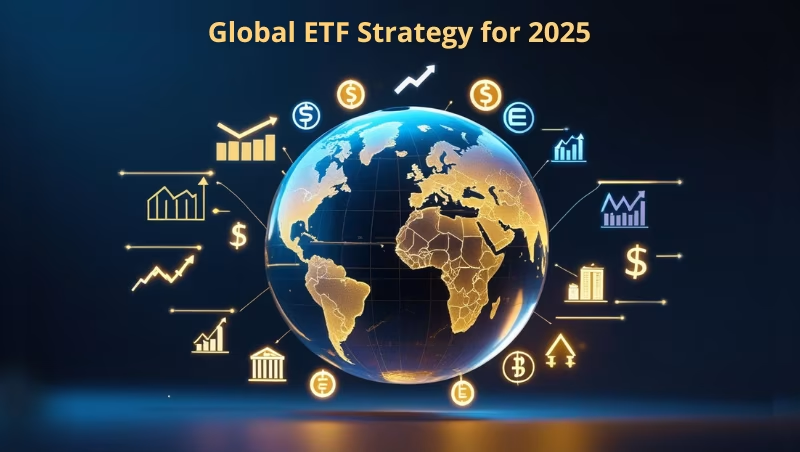Try it now!
Managing your investments has never been easier!

International equity ETFs have been delivering some of their strongest returns in years. Still, many investors remain anchored to familiar domestic holdings — a strategy that could mean missed opportunities and unnecessary risk. Having tracked this shift closely, I've seen how adding exposure to foreign markets not only boosts performance but also helps investors sleep better during periods of U.S. market volatility.
This guide is built for action. Whether you're just starting or fine-tuning your allocations, you'll learn how to use international growth ETFs to build a resilient, well-balanced global portfolio in 2025. All ETF recommendations and data are informed by the 8FIGURES AI Analyst, which tracks performance, volatility, and diversification impact across regions.

The global economy is no longer synchronized. In 2025, U.S. growth is expected to reach 2.0%, while the Eurozone lags at 0.9%. Meanwhile, China is holding at 4.2%—below its historical norm, but still far ahead of developed peers. These regional divergences create global opportunities that simply can't be captured through U.S.-only investing.
Global leadership is always rotating. While the U.S. has led in recent years, emerging markets are expected to maintain or expand their nearly 50% share of global GDP through 2045 and beyond. Investors who stay domestic risk missing the early stages of this transition and the potential for excess return.
The S&P 500 is currently trading at over 21x forward earnings, placing it in the top 10% of historical valuations. Meanwhile, just 10 companies make up more than a third of the index's market cap — a level of concentration that increases vulnerability. With fresh tariffs and a U.S. dollar still trading around 12% above its long-term fair value, the case for international diversification is stronger than ever.
Valuation extremes and concentration risk aren’t new, but in 2025, they’re magnified by geopolitical friction and tech-sector dependency. A U.S.-only portfolio, no matter how strong, remains exposed to risks that diversification can help offset.
Adding international ETFs to your portfolio isn’t just about variety; it’s about building in real resilience. When done right, global allocations offer three core advantages:
Over time, globally diversified portfolios have shown they can match or even slightly outperform U.S.-only strategies, often with less risk. These are not abstract benefits—they translate directly into more consistent, efficient portfolio performance.
Start with your destination. Are you investing for retirement, income, a home purchase? Your timeline defines how aggressive you can afford to be. If you're 20 years out, you can take more risks. If you're three years from needing the funds, stability becomes the priority. Think about how you would react to a sudden 20% drop in your portfolio. It’s a good litmus test for your real tolerance.
Asset allocation is the most powerful decision you'll make. While the 60/40 portfolio remains a popular base, it's not a rule. Conservative investors might prefer 50/50 or even 40/60 (stocks/bonds). Those seeking higher long-term returns might tilt toward equities or include alternatives like REITs and private credit. What matters is matching your mix to your goals and stress tolerance.
Exchange-traded funds (ETFs) simplify global investing. For example, the Vanguard Total International Stock ETF (VXUS) gives you access to more than 8,500 foreign stocks across developed and emerging markets, all for a 0.05% expense ratio. You can go broader or more focused: iShares' IEFA focuses solely on developed market countries outside the U.S., while Vanguard's VWO targets high-growth emerging economies. You can even fine-tune by sector, for instance, overweighting global healthcare or clean energy.
Want to see how global ETFs would reshape your actual portfolio? Use 8FIGURES to simulate diversification impact and get AI-powered recommendations tailored to your holdings.
A set-it-and-forget-it portfolio quickly drifts off course. Volatile sectors grow too large, safe ones shrink. Rebalancing, ideally once or twice a year, keeps your risk aligned with your intent. Use set thresholds or calendar-based rebalancing to avoid emotionally timed trades and market timing mistakes.
VXUS offers the broadest international exposure available, holding more than 8,500 companies across both developed and emerging markets. It uses market-cap weighting to ensure natural regional balance and has returned 18.3% YTD. With a minimal 0.05% expense ratio (just 5 basis points), it remains one of the most efficient vehicles for global diversification.
IEFA provides targeted access to overseas developed markets outside North America, including Europe, Japan, and Australia. Its 2,600+ holdings avoid exposure to the U.S. and Canada, helping investors reduce home-country bias. The fund has posted a 20.31% YTD return and charges just 0.07% annually.
VWO gives you exposure to fast-growing economies like China, India, and Brazil. It includes a broad range of companies by size and sector and uses market-cap weighting. With a 13.05% YTD return and a 0.07% fee, it offers cost-effective access to regions many portfolios neglect entirely.
VYMI focuses on high-dividend companies outside the U.S., offering a 4.1% dividend yield. It includes around 1,550 holdings spread across Europe, Asia-Pacific, and emerging markets. The fund has gained popularity among investors seeking dividend income and diversification in one package.
For investors seeking active management, BINV uses a value-oriented approach to identify underpriced international stocks. The fund includes names like Heineken and Takeda Pharmaceutical, alongside exposure to firms like Alibaba Group. It has delivered a 22.36% YTD, outperforming many passive peers.
DEEF uses a multi-factor strategy, combining value, momentum, quality, and size screens, to build a well-balanced developed-market portfolio. Its smart beta design has paid off, with a year-to-date return of 20.65%. The fund remains broadly diversified, with only 6.5% of assets allocated to its top 10 holdings, and no single position exceeding 1% of assets under management.

Vanguard's Total International Bond ETF (BNDX) is often overlooked, but it plays a crucial role in smoothing out equity risk. It invests in high-quality foreign bonds while hedging currency exposure, protecting you from FX-driven volatility. A 20–30% allocation of your bond holdings to global fixed income can offer meaningful diversification.
Currency swings can amplify or drag down returns. When the dollar weakens, unhedged international assets gain an edge. Hedged ETFs remove this volatility, but also cap your upside. You can hedge selectively (e.g., in bonds) or split your allocation between hedged and unhedged equity funds based on your view.
Stick to U.S.-listed ETFs to avoid PFIC rules and maintain tax efficiency. While some foreign income may be subject to withholding, the IRS allows you to claim a foreign tax credit in many cases. Not sure how this impacts your situation? Use 8FIGURES AI to analyze your portfolio’s tax exposure and get personalized insights.
Many global ETFs include overlapping holdings, especially in large-cap sectors. For example, VXUS and VWO both include emerging markets. Use a portfolio analyzer to track sector weights and country weightings. Aim for true diversification, not just multiple ticker symbols.
Global diversification through international ETFs is no longer optional — it's essential. In 2025, the macro environment rewards those who look beyond borders. With economic momentum rotating and U.S. valuations stretched, portfolios that include thoughtful international exposure are better positioned for both risk reduction and opportunity capture.
The six ETFs we've highlighted, VXUS, IEFA, VWO, VYMI, BINV, and DEEF, each serve a distinct role in building a global investment strategy. Whether your focus is broad exposure, income, emerging markets, or smart beta, these funds offer the building blocks to create a more resilient portfolio.
Even a modest allocation to international assets can materially improve your portfolio's performance over time. Let 8FIGURES help you build a smarter global portfolio, powered by data, tailored to your goals, and optimized for the best ETFs to buy in today's dynamic global market.
Managing your investments has never been easier!